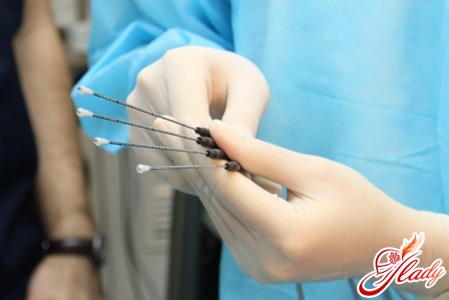
Cervical leukoplakia (cervicalleukoplakia) is a pathology that affects the cervix and induces the cornification of flat epithelial cells. In a normal state, the inner surface of the vagina and the cervix are a soft mucous membrane of light pink color, similar to the inner surface of the cheek, for example. When the disease occurs on the mucosa appear corneal areas of pale color or white plaques, which is why it got its name: leukoplakia in Greek means "white plaque." There are two forms of leukoplakia: simple and scaly. A simple form is sometimes imperceptible in the usual gynecological examination and can be detected only when colposcopy is performed. The scaly is clearly visible and can be diagnosed on examination. Among diseases of the cervix uteri, leukoplakia occupies a special position, since its origin and the possibility of transition to malignant formation have not been fully clarified.

Causes of pathology
Modern medical research indicates a number of factors that may cause leukoplakia of the cervix:
- transferred infectious diseases;
- traumatic effects on the mucosa during labor or abortion, surgical interventions;
- incorrect or untimely treatment of other pathologies of the cervix (erosion, for example);
- in women of reproductive age, leukoplakia is often preceded by various inflammations of the uterus and appendages;
- recently there were data on the relationship of many diseases of the cervix with hormonal disorders.
Therefore, at risk for the emergence of leukoplakia are women with inflammation of the genital area, erosions and menstrual irregularities.
Cervical leukoplakia: symptoms and diagnosis
Disease often occurs without pronouncedsymptoms. Usually leukoplakia of the cervix is detected during a regular examination at the gynecologist. Occasionally, as signs of a woman's illness, the soreness of the sexual intercourse and minor bleeding after it are noted. Sometimes, as symptoms, you can call abundant discharge (whites). If there is a suspicion of leukoplakia, the doctor will prescribe a test, which includes:
- colposcopy: it will give an opportunity to assess the size and nature of the pathology, the state of the mucous membrane of the cervix;
- cytological examination - smear from the surface of the epithelium;
- biopsy of affected areas: since the smear usually does not show the occurrence of changes in the cells of the deep layers due to the stratum corneum, the biopsy is designed to detect the presence of altered (atypical) cells, which may indicate the transition of a simple form of pathology to a precancerous state.

Treatment of leukoplakia
If as a result of the conducted researcha woman was diagnosed with leukoplakia, this should not cause panic or lead to depression. The disease is successfully treated, and even with an atypical form, recovery is possible. Of course, with the diagnosis of cervical leukoplakia, treatment should be prescribed only by a doctor. No advice of traditional medicine and communication on the forums can not replace adequate treatment under the supervision of a specialist gynecologist. When leukoplakia is combined with inflammatory processes and infections of the genital area, the doctor will first prescribe antibacterial or antifungal agents, treatment for chlamydia or trichomonads, depending on the nature of the concomitant disease. And only after its elimination it will be possible to conduct a qualitative treatment of leukoplakia. Therefore, it is important to carefully follow all the recommendations of the doctor and do not resort to self-medication. Douching with herbal decoctions or using tampons with sea buckthorn oil, ointment with aloe and the like. agents that affect tissue metabolism, can promote cell degeneration and the emergence of a precancerous state of epithelial cells in affected areas. Accidental injury during these procedures also can affect the course of the disease. Among the agents for the treatment of leukoplakia, young, non-empowered women use chemical coagulants. The agent is applied directly to the affected areas and destroys the keratinized cells painlessly and completely, providing an effective cure in 74.5% of cases. When cryotherapy, the doctor acts on the source of the disease at a very low temperature. Usually it is a one-time procedure lasting from 2 to 5 minutes, depending on the vastness of the affected area. The procedure is painless and performed on an outpatient basis. Treatment comes in 75-96% of cases. With hormonal disorders, the disease can occur again. The most modern method is laser vaporization. It is a bloodless, painless and non-contact method. When the laser is exposed, the altered tissues evaporate, and a thin coagulation film forms on the surface of the treated area, which prevents penetration of the infection into the wound. Complete healing occurs on 16-40 days. In advanced cases associated with deformity and enlargement of the cervix, surgical treatment may be required with excision of the affected area or amputation of the cervix. Therefore, the only correct behavior in diagnosed leukoplakia will be the timely passage of examination and treatment under the supervision of a doctor.
Preventive measures
Among the measures that prevent the appearance and development of cervical leukoplakia, you can name:
- early treatment of erosions, inflammations and infections of the female sexual sphere;
- prevention of trauma of the cervix during abortion or other manipulations;
- prevention of sexually transmitted diseases;
- observation in the endocrinologist for violations of the monthly cycle, treatment of hormonal disorders;
- visit a gynecologist for the purpose of preventive examination twice a year.
Take care of yourself and be well!









